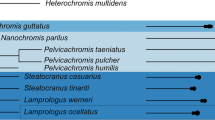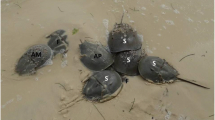Abstract
Theoretical models predict that in external fertilisers, sperm competition risk selects for larger testes and larger sperm with higher velocity, at the expense of sperm longevity. Although several empirical studies have tested this prediction within a fish species, there has been little evidence that an individual male can adjust his testis size and sperm traits according to the risk of sperm competition. Using the cooperatively breeding cichlid Julidochromis transcriptus, we examined testis size and sperm traits (sperm size, velocity and longevity) of males that were assigned to monogamous pairs (without risk of sperm competition) or cooperatively polyandrous trios composed of two males and one female (with risk); the groups were reared for breeding for 2 or more months. Our experiments showed that the polyandrous males, both siring eggs in a clutch, had larger relative testis mass than the monogamous males. However, sperm traits were unrelated to sperm competition. These results suggest that individual males of J. transcriptus can adjust their testis size but not sperm traits in response to sperm competition risk. We also examined the effect of testis investment on growth rate and the somatic condition of males. Increased investment in testes slowed growth rates, whereas testis investment did not affect somatic condition, indicating a trade-off between investment in testes and growth. We conclude that testis investment, in response to perceived sperm competition risks, occurs at the expense of growth and may be a conditional reproductive strategy that is determined by the social status (monogamous or polyandrous) of each J. transcriptus male.




Similar content being viewed by others
References
Awata S, Munehara H, Kohda M (2005) Social system and reproduction of helpers in a cooperatively breeding cichlid fish (Julidochromis ornatus) in Lake Tanganyika: field observations and parentage analyses. Behav Ecol Sociobiol 58:506–516
Awata S, Takeuchi H, Kohda M (2006a) The effect of body size on mating system and parental roles in a biparental cichlid fish (Julidochromis transcriptus): a preliminary laboratory experiment. J Ethol 24:125–132
Awata S, Heg D, Munehara H, Kohda M (2006b) Testis size depends on social status and the presence of male helpers in the cooperatively breeding cichlid Julidochromis ornatus. Behav Ecol 17:372–379
Ball MA, Parker GA (1996) Sperm competition games: external fertilization and ‘adaptive’ infertility. J Theor Biol 180:141–150
Balshine S, Leach BJ, Neat F, Werner NY, Montgomerie R (2001) Sperm size of African cichlids in relation to sperm competition. Behav Ecol 12:726–731
Birkhead TR, Møller AP (1998) Sperm competition and sexual selection. Academic, London
Burness G, Casselman SJ, Schulte-Hostedde AI, Moyes CD, Montgomerie R (2004) Sperm swimming speed and energetics vary with sperm competition risk in bluegill (Lepomis macrochirus). Behav Ecol Sociobiol 56:65–70
Burness G, Moyes CD, Montgomerie R (2005) Motility, ATP levels and metabolic enzyme activity of sperm from bluegill (Lepomis macrochirus). Comp Biochem Physiol 140:11–17
Casselman SJ, Schulte-Hostedde AI, Montgomerie R (2006) Sperm quality influences male fertilization success in walleye (Sander vitreus). Can J Fish Aquat Sci 63:2119–2125
Cohen J (1988) Statistical power analysis for the behavioral sciences, 2nd edn. Lawrence Erlbaum Associates, Hillsdale, NJ
Cortina JM, Nouri H (2000) Effect size for ANOVA designs. Sage University Papers Series on quantitative applications in the social sciences. Sage, no. 07-129, Thousand Oaks, CA
Dewsbury DA (1982) Ejaculate cost and male choice. Am Nat 119:601–610
de Fraipont M, Fitzgerald GJ, Guderley H (1993) Age-related differences in reproductive tactics in the three-spined stickleback, Gasterosteus aculeatus. Anim Behav 46:961–968
Fitzpatrick JL, Desjardins JK, Stiver KA, Montgomerie R, Balshine S (2006) Male reproductive suppression in the cooperatively breeding fish Neolamprologus pulcher. Behav Ecol 17:25–33
Fitzpatrick JL, Desjardins JK, Milligan N, Montgomerie R, Balshine S (2007) Reproductive-tactic-specific variation in sperm swimming speeds in a shell-brooding cichlid. Biol Reprod 77:280–284
Gage MJG, Stockley P, Parker GA (1995) Effects of alternative male mating strategies on characteristics of sperm production in the Atlantic salmon (Salmo salar): theoretical and empirical investigations. Philos Trans R Soc B 350:391–399
Gage MJG, Stockley P, Parker GA (1998) Sperm morphometry in the Atlantic salmon. J Fish Biol 53:835–840
Gage MJG, Macfarlane C, Yeates S, Shackleton R, Parker GA (2002) Relationships between sperm morphometry and sperm motility in the Atlantic salmon. J Fish Biol 61:1528–1539
Gage MJG, Macfarlane CP, Yeates S, Ward RG, Searle JB, Parker GA (2004) Spermatozoal traits and sperm competition in Atlantic salmon: relative sperm velocity is the primary determinant of fertilization success. Curr Biol 14:44–47
Gross MR (1982) Sneakers, satellites and parentals: polymorphic mating strategies in North American sunfishes. Z Tierpsychol 60:1–26
Gross MR (1996) Alternative reproductive strategies and tactics: diversity within sexes. Trends Ecol Evol 11:92–98
Heg D, Bachar Z (2006) Cooperative breeding in the Lake Tanganyika cichlid Julidochromis ornatus. Environ Biol Fish 76:265–281
Heg D, Bender N, Hamilton I (2004) Strategic growth decisions in helper cichlids. Proc R Soc B (Suppl) 271:92–98
Hoysak DJ, Liley NR (2001) Fertilization dynamics in sockeye salmon and a comparison of sperm from alternative male phenotypes. J Fish Biol 58:1286–1300
Iwamatsu T, Onitake K, Yoshimoto Y, Hiramoto Y (1991) Time sequence of early events in fertilization in the medaka egg. Dev Growth Differ 33:479–490
Kazakov RV (1981) Peculiarities of sperm production by anadromous and parr Atlantic salmon (Salmo salar L.) and fish cultural characteristics of such sperm. J Fish Biol 18:1–8
Konings A (1998) Tanganyika cichlids in their natural habitat. Cichlid, El Paso
Kortet R, Vainikka A, Rantala MJ, Taskinen J (2004) Sperm quality, secondary sexual characters and parasitism in roach (Rutilus rutilus L.). Biol J Linn Soc 81:111–117
Kuwamura T (1997) The evolution of parental care and mating systems among Tanganyikan cichlids. In: Kawanabe H, Hori M, Nagoshi M (eds) Fish communities in Lake Tanganyika. Kyoto University Press, Kyoto, pp 57–86
Levitan DR (2000) Sperm velocity and longevity trade off each other and influence fertilization in the sea urchin Lytechinus variegatus. Proc R Soc B 267:531–534
Liley NR, Tamkee P, Tsai R, Hoysak DJ (2002) Fertilization dynamics in rainbow trout (Oncorhynchus mykiss): effect of male age, social experience, and sperm concentration and motility on in vitro fertilization. Can J Fish Aquat Sci 59:144–152
Matthes H (1959) Un Cichlidae nouveau du lac Tanganika. Julidochromis transcriptus n. sp. Rev Zool Bot Afr LX 1–2:126–130
Nakagawa S (2004) A farewell to Bonferroni: the problems of low statistical power and publication bias. Behav Ecol 15:1044–1045
Nakatsuru K, Kramer DL (1982) Is sperm cheap? Limited male fertility and female choice in the lemon tetra (Pisces, Characidae). Science 216:753–755
Neff BD, Fu P, Gross MR (2003) Sperm investment and alternative mating tactics in bluegill sunfish (Lepomis macrochirus). Behav Ecol 14:634–641
Parker GA (1970) Sperm competition and its evolutionary consequences in the insects. Biol Rev 45:525–567
Parker GA (1982) Why are there so many tiny sperm? Sperm competition and the maintenance of two sexes. J Theor Biol 96:281–294
Parker GA (1990) Sperm competition games: sneaks and extra-pair copulations. Proc R Soc B 242:127–133
Parker GA (1998) Sperm competition and the evolution of ejaculates: towards a theory base. In: Birkhead TR, Møller AP (eds) Sperm competition and sexual selection. Academic, London, pp 3–54
Petersen CW, Warner RR (1998) Sperm competition in fishes. In: Birkhead TR, Møller AP (eds) Sperm competition and sexual selection. Academic, London, pp 435–463
Roff DA (1992) The evolution of life histories. Chapman and Hall, New York
Rudolfsen G, Fingenschou L, Folstad I, Tveiten H, Fingenschou M (2006) Rapid adjustments of sperm characteristics in relation to social status. Proc R Soc B 273:325–332
Schulte-Hostedde AI, Burness G (2005) Fertilization dynamics of sperm from different male mating tactics in bluegill (Lepomis macrochirus). Can J Zool 83:1638–1642
Shapiro DY, Marconato A, Yoshikawa T (1994) Sperm economy in a coral reef fish, Thalassoma bifasciatum. Ecology 75:1334–1344
Snook RR (2005) Sperm in competition: not playing by the numbers. Trends Ecol Evol 20:46–53
Stearns SC (1989) Trade-offs in life-history evolution. Funct Ecol 3:259–268
Stearns SC (1992) The evolution of life histories. Oxford University Press, Oxford
Stoltz JA, Neff BD (2006) Sperm competition in a fish with external fertilization: the contribution of sperm number, speed and length. J Evol Biol 19:1873–1881
Taborsky M (1994) Sneakers, satellites, and helpers: parasitic and cooperative behavior in fish reproduction. Adv Study Behav 23:1–100
Taborsky M (1997) Bourgeois and parasitic tactics: do we need collective, functional terms for alternative reproductive behaviours? Behav Ecol Sociobiol 41:361–362
Taborsky M (1998) Sperm competition in fish: ‘bourgeois’ males and parasitic spawning. Trends Ecol Evol 13:222–227
Taborsky M (2001) The evolution of bourgeois, parasitic, and cooperative reproductive behaviors in fishes. J Heredity 92:100–110
Tomkins JL, Simmons LW (2002) Measuring relative investment: a case study of testes investment in species with alternative male reproductive tactics. Anim Behav 63:1009–1016
Uglem I, Rosenqvist G, Wasslavik HS (2000) Phenotypic variation between dimorphic males in corkwing wrasse. J Fish Biol 57:1–14
Uglem I, Galloway TF, Rosenqvist G, Folstad I (2001) Male dimorphism, sperm traits and immunology in the corkwing wrasse (Symphodus melops L.). Behav Ecol Sociobiol 50:511–518
Vladic TV, Järvi T (2001) Sperm quality in the alternative reproductive tactics of Atlantic salmon: the importance of the loaded raffle mechanism. Proc R Soc B 268:2375–2381
Vladic TV, Afzelius BA, Bronnikov GE (2002) Sperm quality as reflected through morphology in salmon alternative life histories. Biol Reprod 66:98–105
Warner RR (2001) Synthesis: environment, mating systems, and life history allocations in the bluehead wrasse. In: Dugatkin LA (ed) Model systems in behavioral ecology. Princeton University Press, Princeton and Oxford, pp 227–244
Warner RR, Robertson DR, Leigh EG Jr (1975) Sex change and sexual selection. Science 190:633–638
Wedell N, Gage MJG, Parker GA (2002) Sperm competition, male prudence and sperm-limited females. Trends Ecol Evol 17:313–320
Wootton RJ (1998) Ecology of teleost fishes, 2nd edn. Klumer Academic, Dordrecht
Yamagishi S, Kohda M (1996) Is the cichlid fish Julidochromis marlieri polyandrous? Ichthyol Res 43:469–471
Yeates S, Searle J, Ward RG, Gage MJG (2007) A two-second delay confers first-male fertilization precedence within in vitro sperm competition experiments in Atlantic salmon. J Fish Biol 70:318–322
Zimmerer EJ, Kallman KD (1989) Genetic basis for alternative reproductive tactics in the pygmy swordtail, Xiphophorus nigrensis. Evolution 43:1298–1307
Acknowledgements
We thank J. Shibata and K. Ota for their help during the aquarium experiments, and Y. Tarui, H. Muhehara, Y. Hayakawa, R. Kato, R. Tamai, M. Miyata and the members of the Laboratory of Cell Biology, Osaka City University, for their help with the measurements of sperm concentration and sperm traits. We are also grateful to D. Heg, Y. Nakashima, K. Karino, D. Gomagano, K. Lindström and two anonymous referees for their comments on an earlier draft of this manuscript. This study received financial support to M.K. from a Grant-in-Aid for Scientific Research from the Japanese Ministry of Education, Culture, Sports, Science and Technology and was partly supported by the 21st Century COE program of the University of the Ryukyus and Research Fellowships of the Japan Society for the Promotion of Science for Young Scientists to S.A. The research presented here was performed in compliance with the guideline of the Animal Care and Use Committee of Osaka City University and the Japan Ethological Society.
Author information
Authors and Affiliations
Corresponding author
Additional information
Communicated by K. Lindström
Rights and permissions
About this article
Cite this article
Awata, S., Takeyama, T., Makino, Y. et al. Cooperatively breeding cichlid fish adjust their testis size but not sperm traits in relation to sperm competition risk. Behav Ecol Sociobiol 62, 1701–1710 (2008). https://doi.org/10.1007/s00265-008-0598-0
Received:
Revised:
Accepted:
Published:
Issue Date:
DOI: https://doi.org/10.1007/s00265-008-0598-0




